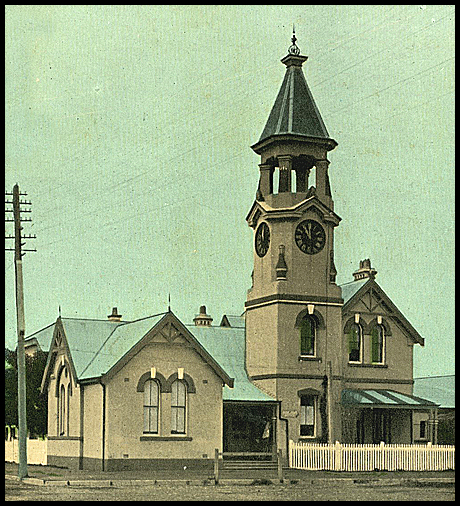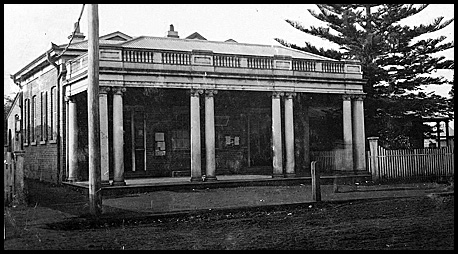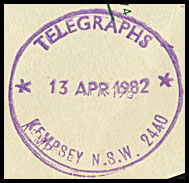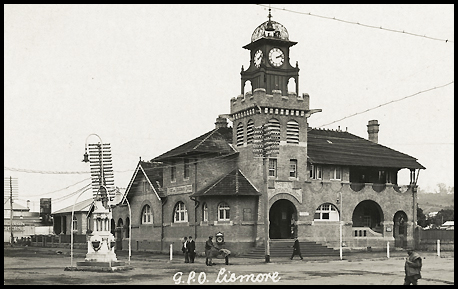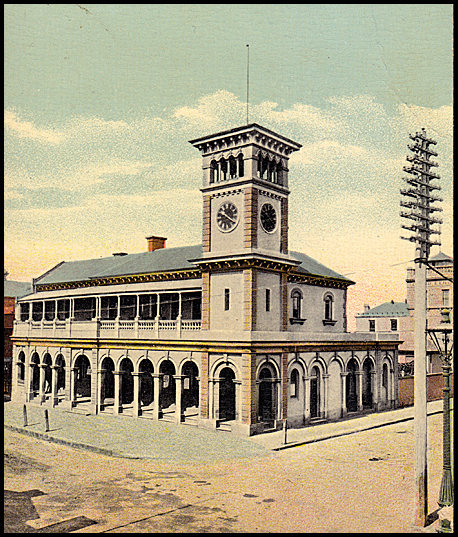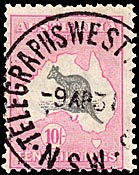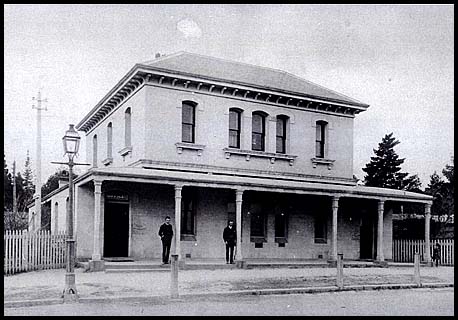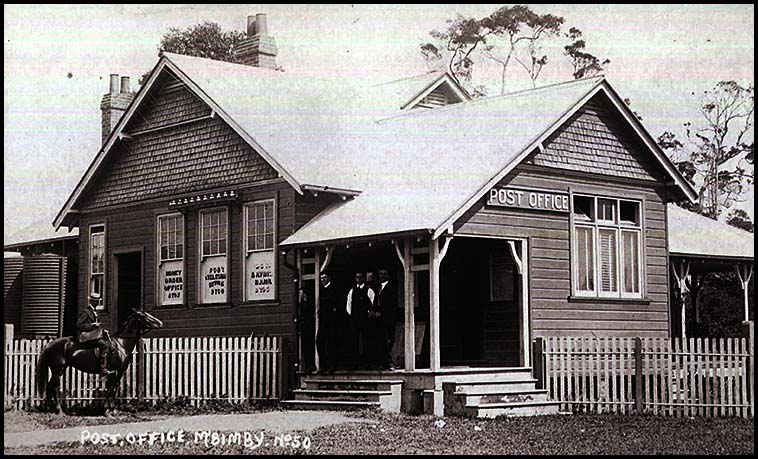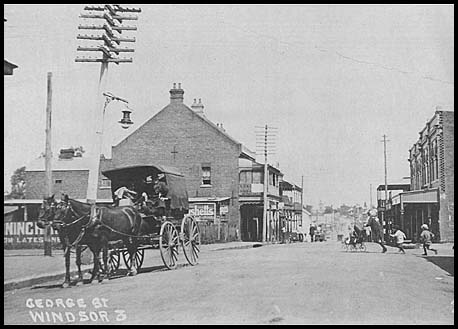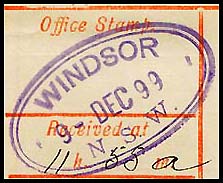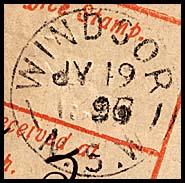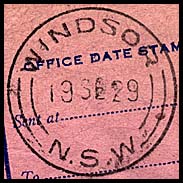Telegraph Offices in the north-east region.
- Home, index, site details
- Australia 1901-1988
- New South Wales
- Overview of NSW
- Telegraph lines
- Telegraph Offices
- Date stamps
- Forms
- Envelopes
- Rates
- Stamps
- Queensland
- Overview of Qld
- Telegraph lines
- Telegraph offices
- Date stamps
- Forms
- Envelopes
- Rates
- Stamps
- South Australia
- Overview of SA
- Telegraph lines
- Telegraph Offices
- Date stamps
- Forms
- Envelopes
- Rates
- Stamps
- Tasmania
- Overview of Tasmania
- General developments
- Reports
- Organisation
- Telegraph lines
- Telegraph Offices
- Date stamps
- Railway lines
- Forms
- Envelopes
- Rates
- Stamps
- Overview of Tasmania
- Victoria
- Overview of Vic.
- Telegraph lines
- Telegraph offices
- Date stamps
- Forms
- Envelopes
- Rates
- Stamps
- Ephemera
- Western Australia
- Overview of WA
- Telegraph lines
- Telegraph Offices
- Date stamps
- Forms
- Envelopes
- Rates
- Stamps
The following Telegraph Offices are included in this page:
| Ballina | Casino | Coffs Harbour | Dungog | Grafton |
| Greta | Kempsey | Kurri Kurri | Lambton | Lismore |
| Maitland | Maitland East | Mullumbimby | Murrurundi | Murwillumbah |
| Port Macquarie | Uralla | Windsor | Wyong |
| Coffs Harbour.
The Telegraph Office was opened as a P&T Office on 24 August 1891. The Post Office had opened on1 August 1890. |
 Post and Telegraph Office at Coffs Harbour. |
|
A Telegraph Office was opened on 7 July 1874. |
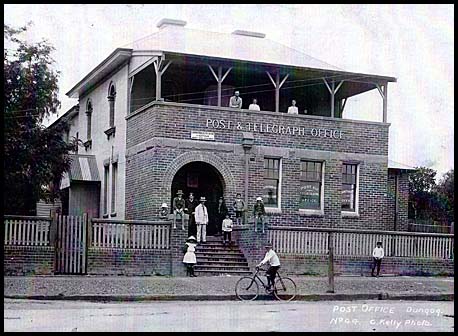 Dungog Post & Telegraph Office about 1910. |
| Grafton.
The Telegraph Office opened on 17 December 1862 with Messrs. Nunn and Smithers in charge. The Post Office had opened as Clarence River on 1 October 1849 and changed name about 1849. The Telegraph Office merged with the Post Office on 1 January 1870. In the 1890s, Mr. R. C. Williams was in charge. The memoirs of Mr. W. Orr from his appointment as a Telegraph Messenger at Grafton to his retirement were published in the Northern Star of 25 June 1934. The Sydney Morning Herald of 19 November 1868 reported on a meeting in the School of Arts. In part "it was not deemed necessary that provision should be made for the erection of a (Post Office) building, as it is considered that sufficient accommodation could be provided by making such additions to the Electric Telegraph Office as would render that office suitable for the double purpose of Post and Telegraph office. With reference to the appointment of an Official Postmaster, it has of late been found expedient, on the grounds of economy, and also on the ground that the plan is one which offers all the advantages of an official Post Office, to amalgamate the duties of Postmaster and Telegraph Station master". |
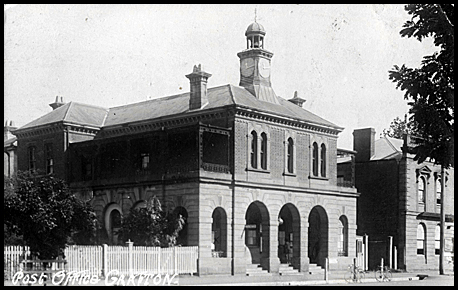 The 1875 Grafton Post & Telegraph Office. |
|
 |
||
In "The Blue Book" for 1870, the Grafton Post & Telegraph Office is recorded as:
"And yet the whole of this business, most of which is of the greatest importance to the general public, is obliged to be carried on in a room scarcely twelve feet square. In this miserable room, the employees of the establishment have to perform all the operations of the telegraph, and attend to all and several of the other duties of the establishment. The access to this wonderful place is by a small lobby of about four feet square, surrounded by a partition covered with green baize, by means of a small hole in the partition of about six inches square; within this little lobby visitors, are supposed to write their telegrams, purchasers secure their stamps, depositors pay their money and all enquiries about Post-Office matters are supposed to be made. Under such circumstances, secrecy is impossible. If an attempt be made to write a telegraphic slip, you are hindered by a host of enquirers and waiters upon other matters; the only alternative for a quiet citizen is to wait out in the street, till fortune smiles upon him and gives him an opportunity of access into the public hall of this magnificent establishment. If even a verandah was erected in the front, waiters would be in the dry and out of the heat and dust, but alas that is a luxury - which is too far in the distance for Grafton. We have become so accustomed to the thing that perhaps, any alteration would be regarded an innovation, and would be looked upon as a reckless expenditure in these days of retrenchment. But why should such a state of things remain - public convenience should not be ignored altogether. Other places in the colony have respectable Post and Telegraph Offices. Why should Grafton and the Clarence be the exception? This matter has again and again been brought under the notice of the Government - promises have been made and reiterated, but still the same neglect". (The Clarence and Richmond Examiner 16 April 1872, p. 2). Tenders for the "Erection of a Telegraph Station at Grafton" closed on 23 September 1873. The laying of the Foundation Stone for the new building in Victoria Street took place on 8 October 1874. |
||
A steel circular Type 2C TELEGRAPHS GRAFTON date stamp was used at Grafton:
|
 12 May 1935. Small Multiple watermark. |
 22 January 1945. Used on AW-DO-9E. |
| Greta.
On 30 June 1875, the Miners Advocate reported that "Our Anvil Creek and Greta friends will be pleased to learn that tenders are being called for the erection of a Post and Telegraph Office at Anvil Creek. This will indeed prove a boon for such offices are badly wanted". A Post & Telegraph Office was opened in Greta on 1 October 1886. On 30 May 1906, the Telegraph Office was reclassified as a Telephone Service but it continued to handle all telegraphic matters. A Telegraph Office was opened at the Railway Station on 14 September 1894 but it had closed by 1902. Greta had a coal mine which produced low grade coal. When prices fell in the early 1890s, the mine became unprofitable and it closed in 1894. |
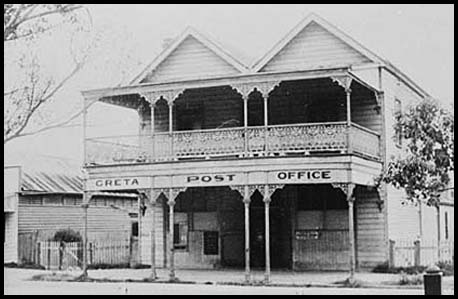 Greta Post Office April 1893 - no reference to the Telegraph. Greta Post Office April 1893 - no reference to the Telegraph.The image was scanned from the original glass negative taken by Ralph Snowball. Reproduced with acknowledgment of the Norm Barney Photographic Collection in the Cultural Collections at the University of Newcastle. Source: livinghistories.newcastle.edu.au/nodes/view/43201 |
In May 1902, the Government Architect received instructions from the Postmaster-General to carry out alterations to the Post & Telegraph Office. On 8 April 1904, the Newcastle Herald reported that new telegraph poles had arrived to enable the local Post & Telegraph office to be connected to the main line. On 30 May 1906, the Newcastle Herald reported: "The telephone at the post-office, having been connected with Branxton, the telegraph instruments, etc., have been dispensed with and were taken away on Tuesday afternoon. Consequently all telegrams to and from Greta will have to be repeated at Branxton. Mr. Edmondson, from Maitland post office, who has been relieving here for several weeks owing to the illness of Mr. Jackson, Postmaster, will now return to Maitland leaving the post-office in charge of Mrs. and Miss Jackson until Mr. Jackson, son of the former, recovers and is able to take charge. Arrangements have been made so that messages sent and received will be private". In 1913, the Post & Telegraph Mistress - Miss F Quinn - was replaced by Mr. H. J. Nowland. Miss Quinn and her two sisters - who had acted as assistants for the previous three years, were returning to Sydney. Mr Nowland announced he was expecting an additional telephone bureau and new telegraph equipment to be arriving shortly. |
|
| The letter on the back of the postcard at the right is dated 19th Nov (19)16 and it states: Dear Stan I suppose you recognise this office in which you reigned as P.M. for a time. The photographer was ashamed to put his name on it. I suppose you will recognise Mum. Jenton is the messenger. My sister & I on the balcony. She is the worst looking one. Harold was nowhere to be found. We have let the attics to the Starling family. By the sound up there I think there are several generations. The trouble is the rent question. We've been here 3 months now and not a penny have we got. |
 The Greta Post & Telegraph Office about 1905. |
| Kempsey.
The Telegraph Office opened (in Central Kempsey) in 1878 and merged with the Post Office on 1 July 1880. The Post Office had opened on 1 September 1843. |
||
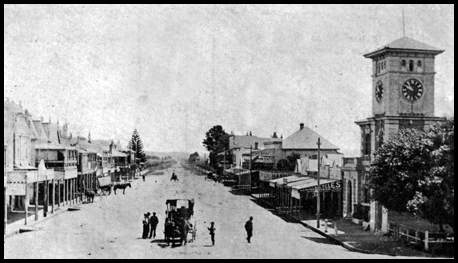 An earlier picture of the Post Office based on a comparison with the fewer and simpler telegraph poles outside compared to the picture at the right. In addition, the clock says its 30 minutes earlier :-). |
 |
|
|
||
| Three types of date stamp were issued to Kempsey for use with the telegraphs: | ||
|
|
|
|
 19 December 1977. Used on AT-TO-15A. |
|
|
Used on AT-DO-14B. |
|
| A Telegraph Office also opened at the Railway Station on 28 April 1924 although no special date stamp is recorded. It closed on 30 June 1962. | ||
|
A Telegraph Office was opened on 22 August 1905. |
 |
|
|
A Post Office was opened at Lambton on 1 March 1865. The Telegraph Office opened on 31 May 1875. The two offices merged in to Post & Telegraph Office on 19 November 1878. |
|
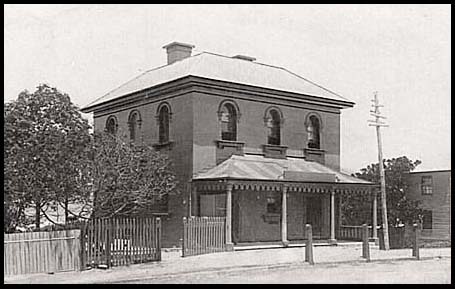 |
 Lambton Post & Telegraph Office about 1900. |
| Lismore.
The Telegraph Office opened on 1 December 1875 and merged with the Post Office on 1 March 1875. The Post Office had opened on 1 October 1859. In 1897, a tender of £ 3,340 was accepted to erect a new building designed by the Government Architect W. Vernon in the Federation style. It was opened on 1 December 1898. |
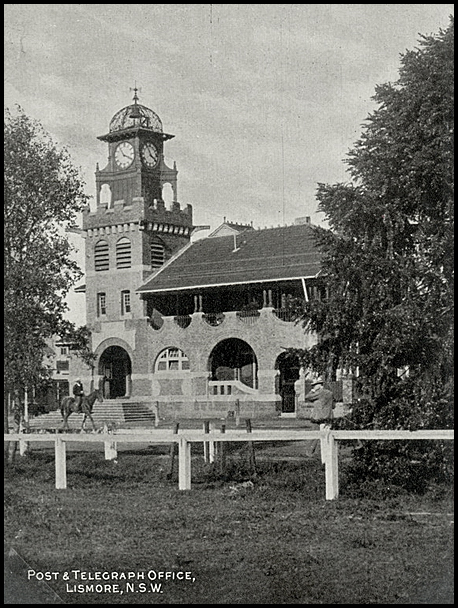 |
The photographs below show little change to the P&T building (except to the front steps) but lots of changes to nearby structures. |
|
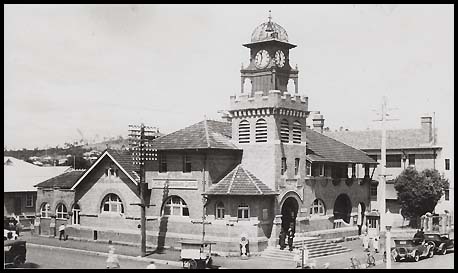 |
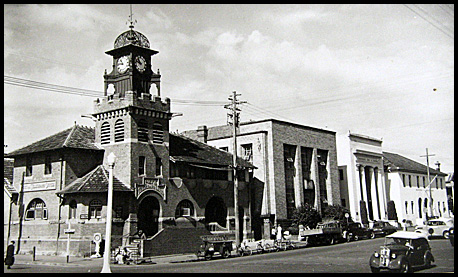 |
| No special date stamp was issued to the Lismore Telegraph Office for use with telegraphic matters. The usual postal date stamp was used on telegram forms and (sometimes) on delivery envelopes.
|
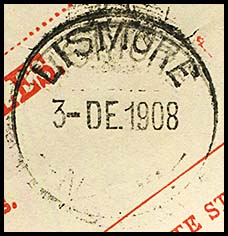 3 December 1908. Used on NSW delivery form NI-DO-4C with delivery envelope shown as NC-EO-5E. |
| The only TELEGRAM slogan cancellation recorded as having been used at Lismore is SEND A TELEGRAM.
The only recorded example of its use is on 25 September 1937. |
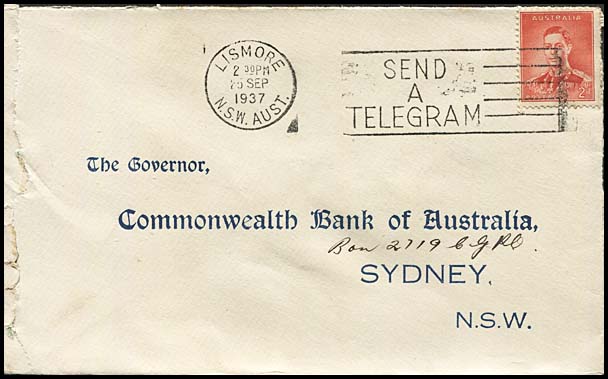 |
|
A Post Office was opened at Maitland on 1 September 1829 and it changed name to West Maitland about 1852. On 2 October 1900, the office was upgraded to a Post & Telegraph office. The name of the combined office reverted back to Maitland on 1 April 1949.
|
|
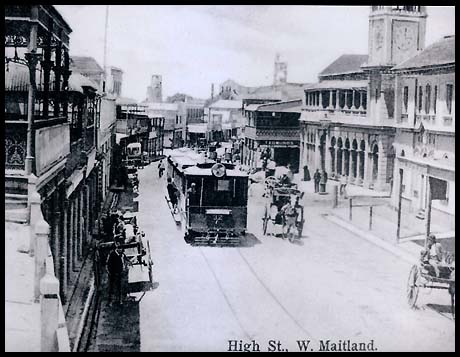 |
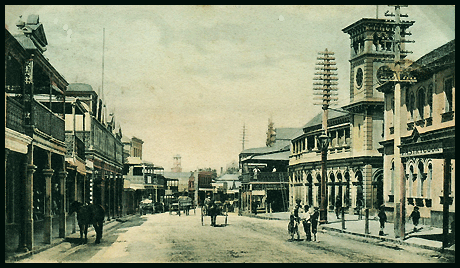 High Street, West Maitland (circa 1890) showing the post office at the right after the second storey and clock tower had been added in 1881. High Street, West Maitland (circa 1890) showing the post office at the right after the second storey and clock tower had been added in 1881. |
A steel circular TELEGRAPHS date stamp (SC1-T) was used at the two offices in three formats:
|
Magnification shows the letter following WEST is an M and the letter at lower right appears to be a D. |
|
|
||
|
|
The Post and Telegraph Office was opened on 1 May 1898. |
|
|
|
|
The Telegraph Office opened at Kynnumboon on 1 November 1875 and merged with the Post Office (as a Post & Telegraph Office) on 7 May 1878. The original Post Office - Wollumben - opened on 1 November 1866 and it changed name to Kynnumboon on 15 August 1868. On 15 April 1882, there was another name change - to Murwillumbah. |
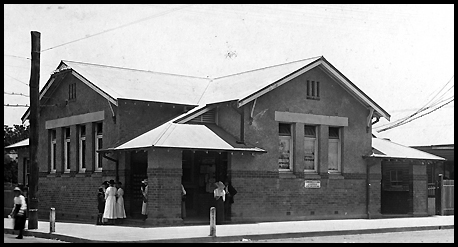 The Murwillumbah Post Office - where some (now old) collectors bought their first stamps as young children to begin collecting. The Murwillumbah Post Office - where some (now old) collectors bought their first stamps as young children to begin collecting. |
| The usual Post Office date stamp was used on telegrams as no special date stamp was issued to Murwillumbah for telegraphic business. |  14 March 1923. |
| Taree.
Hopson & Tobin do not list a Telegraph Office for Taree. Nevertheless, tenders called for the "Erection of a Post & Telegraph Station at Taree" closed on 7 July 1874. |
|
A Telegraph Office was opened at Uralla on 1 December 1867. The Post Office had opened on 1 February 1858. The two offices combined on 1 August 1870. It does not appear that Uralla had a special date stamp issued to it for use with telegraphic work. |
|
Colonial and Interim periods. |
Size: 22 × 38 mm (e = 0.82). Used on NC-DO-10Bc. Used: 9 December 1899 to 13 January 1902. |
Diameter: 24 mm. Used on NC-DO-9A. Used: 19 July 1895 (on NC-DO-10Ba) |
Diameter: 27 mm. Used on NI-DO-4B and NI-DO-6B. Used between 1907 and 1914. |
| Post-1917 (Establishment period): |
Diameter: 27 mm. H&T Type 2A. Used on NI-DO-6B. |
Diameter: 28mm. H&T Type 2B. Used on AB-DU-4A. |
 Windsor straight line hand stamp. 30 June 1897. Used on NC-DO-10A. |
|
A Post & Telegraph Office was established on 22 December 1891. A Post Office had been created when Wyong Railway Station was renamed on 1 April 1889. The Railway office never had telegraph facilities. |
|
A rubber circular TELEGRAMS date stamp (RO1 - T) was issued to the Office for use with telegraphic business. It is the only NSW date stamp inscribed TELEGRAMS.
|
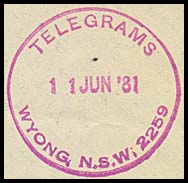 |
